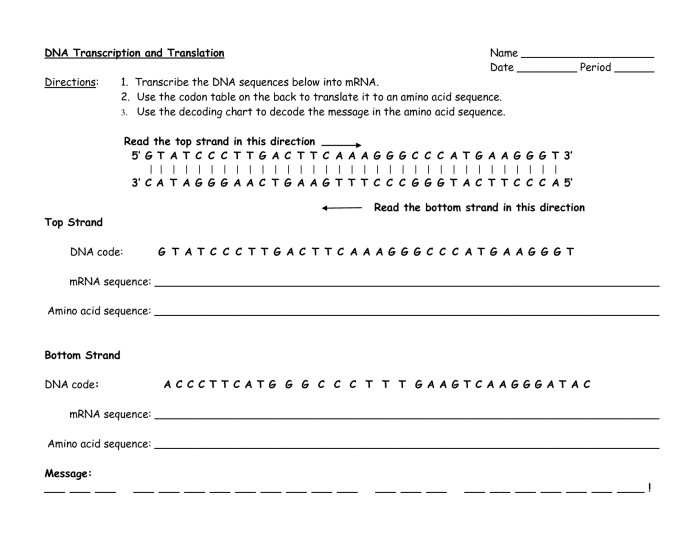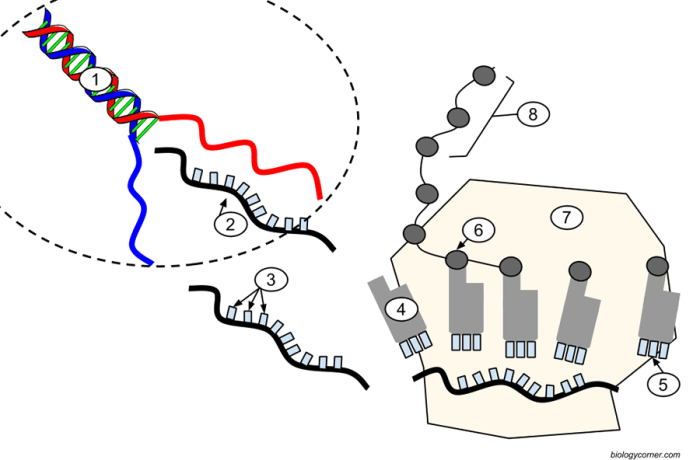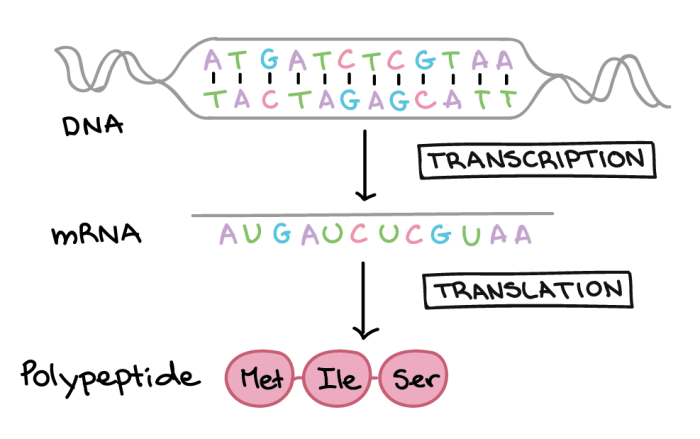Unveiling the intricacies of molecular biology, the transcription and translation biology worksheet empowers students with a profound understanding of these fundamental processes. Delving into the realms of gene expression, this meticulously crafted resource provides a comprehensive exploration of the mechanisms underlying the flow of genetic information from DNA to protein.
Through a captivating journey of knowledge, this worksheet unravels the intricate steps of transcription and translation, highlighting the crucial roles of RNA polymerase and ribosomes. With a blend of lucid explanations and engaging diagrams, students embark on an immersive learning experience that illuminates the very essence of cellular life.
Transcription

Transcription is the process by which genetic information encoded in DNA is copied into RNA. It is an essential step in gene expression, as RNA is the molecule that carries the genetic code to the ribosomes, where proteins are synthesized.
Steps Involved in Transcription, Transcription and translation biology worksheet
- Initiation:RNA polymerase binds to a specific DNA sequence called the promoter, located upstream of the gene to be transcribed.
- Elongation:RNA polymerase unwinds the DNA double helix and synthesizes a complementary RNA strand using one of the DNA strands as a template. The RNA strand is synthesized in the 5′ to 3′ direction.
- Termination:RNA polymerase reaches a specific DNA sequence called the terminator, which signals the end of transcription. The RNA polymerase releases the RNA strand and dissociates from the DNA template.
Role of RNA Polymerase
RNA polymerase is an enzyme that catalyzes the transcription process. It is composed of multiple subunits that work together to unwind the DNA double helix, synthesize the RNA strand, and terminate transcription.
Translation

Translation is the process by which the genetic code carried by mRNA is converted into a sequence of amino acids, which are the building blocks of proteins.
Steps Involved in Translation
- Initiation:The small ribosomal subunit binds to the mRNA and scans for the start codon (usually AUG). The initiator tRNA, which carries the amino acid methionine, binds to the start codon.
- Elongation:The large ribosomal subunit binds to the small ribosomal subunit, forming a complete ribosome. tRNA molecules carrying specific amino acids bind to the mRNA codon by codon. Peptide bonds are formed between the amino acids, creating a growing polypeptide chain.
- Termination:The ribosome reaches a stop codon (UAA, UAG, or UGA) on the mRNA. Release factors bind to the stop codon, causing the ribosome to release the polypeptide chain and dissociate from the mRNA.
Role of Ribosomes
Ribosomes are large, complex structures composed of RNA and protein. They provide the site for translation to occur, bringing together the mRNA, tRNA, and amino acids.
Transcription and Translation Worksheet

Questions:
- Describe the process of transcription, including the role of RNA polymerase.
- Explain the steps involved in translation and the role of ribosomes.
- Compare and contrast the processes of transcription and translation.
Answer Key:
- Transcription:RNA polymerase binds to the DNA promoter and unwinds the double helix. It synthesizes an RNA strand complementary to one of the DNA strands in the 5′ to 3′ direction. Termination occurs when the RNA polymerase reaches a terminator sequence.
- Translation:The small ribosomal subunit binds to the mRNA and scans for the start codon. tRNA molecules carrying specific amino acids bind to the mRNA codon by codon. Peptide bonds are formed between the amino acids, creating a growing polypeptide chain.
Termination occurs when the ribosome reaches a stop codon.
- Comparison:Transcription occurs in the nucleus, while translation occurs in the cytoplasm. Transcription uses DNA as a template, while translation uses mRNA as a template. Transcription produces RNA, while translation produces proteins.
Comparison of Transcription and Translation: Transcription And Translation Biology Worksheet

| Process | Location | Template | Product | Purpose |
|---|---|---|---|---|
| Transcription | Nucleus | DNA | RNA | Copy genetic information from DNA to RNA |
| Translation | Cytoplasm | mRNA | Protein | Convert genetic code in RNA to amino acid sequence in proteins |
Key Differences:
- Transcription involves DNA as the template, while translation involves mRNA.
- Transcription produces RNA, while translation produces proteins.
- Transcription occurs in the nucleus, while translation occurs in the cytoplasm.
Applications of Transcription and Translation
Transcription and translation are essential processes in biotechnology, with applications in:
- Medicine:Gene therapy, genetic testing, and development of new drugs
- Agriculture:Genetic engineering of crops for improved yield and resistance to pests and diseases
- Industry:Production of biofuels, enzymes, and other bioproducts
Future applications may include:
- Personalized medicine:Tailoring treatments to individual genetic profiles
- Synthetic biology:Designing and engineering new biological systems
- Bioremediation:Using microorganisms to clean up environmental pollution
Commonly Asked Questions
What is the significance of RNA polymerase in transcription?
RNA polymerase acts as the molecular machinery that catalyzes the synthesis of RNA molecules, using DNA as the template. It unwinds the DNA double helix, reads the genetic code, and assembles complementary RNA nucleotides, creating an RNA transcript that carries the genetic information.
How do ribosomes contribute to the process of translation?
Ribosomes are the cellular organelles responsible for protein synthesis. They bind to mRNA molecules and decode the genetic code, facilitating the assembly of amino acids into polypeptide chains. Each codon on the mRNA corresponds to a specific amino acid, and the ribosome ensures the correct sequence and folding of the protein.